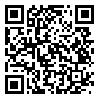1. Nandgaonkar H, Ferzandi Z. Ayres sensory integration for the children with attention deficit and hyperactivity disorder (ADHD): a randomized controlled trial. Int J of Adv Res. 2018;6(11):103–12. [
DOI]
2. Yahyavizanjani M, Taher M, Hosein KhanzadeA, Naghdi M, Mojarrad A. The effectiveness of play therapy based on focusing on the range of attention and impulsivity level in students with attention deficit/ hyperactivity disorder. Psychological Studies. 2020;16(3):23–38. [Persian] [
DOI]
3. Molagholamreza Tabasi F, Aliabadi F, Alizade Zarei M, Qorbani M, Rostami R. The relationship between behavioral problems and sensory processing in children with attention deficit/hyperactivity disorder (ADHD). Middle Eastern Journal of Disability Studies. 2016;6:282–7. [Persian] [
Article]
4. Beik M, NezakatAlhosseini M, Abedi A. Validity and reliability measurement of the cognitive-motor functions test in attention deficit/hyperactivity disorder (ADHD). Journal of Paramedical Sciences & Rehabilitation. 2019;8(1):66–75. [Persian] [
Article]
5. Ebrahimi M, Mahvashe Wernosfaderani A, Haghgoo HA, Pourmohamad Rezaye Tajrishi M, Danaiefard F. The effectiveness of sensory-motor integration with an emphasis on proprioceptive and vestibular senses on the symptoms of attention deficit/ hyperactivity disorder (ADHD). J Res Rehabil Sci. 2013;9(2):220–31. [Persian] [
Article]
6. Pingale V, Fletcher T, Candler C. The effects of sensory diets on children's classroom behaviors. Journal of Occupational Therapy, Schools, & Early Intervention. 2019;12(2):225–38. [
DOI]
7. Camarata S, Miller LJ, Wallace MT. Evaluating sensory integration/sensory processing treatment: issues and analysis. Front Integr Neurosci. 2020;14:556660. [
DOI]
8. Laird CT. The sensory processing diet: one mom's path of creating brain, body and nutritional health for children with SPD. Ann Arbor, MI: Loving Healing Press; 2020.
9. Kumari Sahoo S, Senapati A. Effect of sensory diet through outdoor play on functional behaviour in children with ADHD. Indian J Occup Ther. 2014;46(2):49–54.
10. Sheikhtaheri A, Khanahmadi S, Sourtiji H. A mobile-based sensory diet application to educate parents of children with attention deficit / hyperactivity disorder. Journal of Health Administration. 2022;24(4):11–22. [Persian] [
DOI]
11. Ghanizadeh A. Sensory processing problems in children with ADHD, a systematic review. Psychiatry Investig. 2011;8(2):89. [
DOI]
12. Dehghan F, Mirzakhani N, Alizadeh Zare M, Razjoyan K. The relationship between sensory processing and behavior in children with attention deficit disorder and hyperactivity 7 to 10 years old. Journal of Modern Rehabilitation. 2015;9(3):9-18. [Persian] [
Article]
13. Rathod VJ, Shah V, Alagesan J, Paranthaman PPS. Effect of sensory integration therapy and cognitive behavioral therapy on attention deficit hyperactivity disorder: single blinded study. International Journal of Physiotherapy and Research. 2015;3(2):947–54. [
DOI]
14. Rahmani T, Wulandari, D. Effectiveness of sensory integration therapy in children with ADHD (attention deficit/hyperactivity disorder). Anima, Indonesian Psycho J. 2010;26:69–75.
15. Hatlestad B. The Wilbarger protocol. Biology: Student Scholarship & Creative Works; 2018.
16. Pingale V, Fletcher T, Candler C, Pickens N, Dunlap K. Effects of sensory diets: a single subject study. Journal of Occupational Therapy, Schools, & Early Intervention. 2021:1-16. [
DOI]
17. Wechsler D. WISC-IV: administration and scoring manual. San Antonio: The psychological Corporation; 2003.
18. Conners CK. Conners' Rating Scales–revised: technical manual. North Tonawanda, NY: Multi-Health Systems; 1997.
19. Dunn W. Sensory profile. San Antonio, TX: Psychological Corporation; 1999.
20. Wahlstrom D, Breaux KC, Zhu J, Weiss LG. The Wechsler Preschool and Primary Scale of Intelligence—third edition, the Wechsler Intelligence Scale for Children—fourth edition, and the Wechsler Individual Achievement Test—third edition. In Flanagan DP, Harrison PL. editors. Contemporary intellectual assessment: theories, tests, and issues. New York: The Guilford Press; 2012, pp. 224-48.
21. Sadeghi A, Rabiee M, Abedi MR. Validation and reliability of the Wechsler Intelligence Scale for Children-IV. Developmental Psychology: Iranian Psychologists. 2011;7(28):377–86. [Persian] [
Article]
22. Conners CK. Conners' rating scales-revised: technical manual. North Tonawanda, NY: MHS; 2001.
23. Shahaeian A, Shahim S, Bashash L, Yousefi F. Hanjaryabi, tahlil ameli va payaei forme kootah vizheye valedeyn meghyase daraje bandi Conners' baraye koodakane 6 ta 11 sale dar shahre Shiraz [Standardization, Factor analysis and reliability of the Conners' parent rating scales for 6 to 11 years old children in Shiraz]. Journal of Educational Psychology Studies. 2007;3(3):97–120. [Persian] [
DOI]
24. Mirzakhani N, Zeynali R, Fendereski T, Dehghan F, Malak H. Normalization of sensory profile questionnaires in Iranian children (5-12-year-old). Shahid Beheshti University of Medical Science Rehabilitation School. 2012:123–8. [Persian]
25. Peterson M, Hunt A, White E. Survey of sensory diet use among California occupational therapy practitioners [Thesis for MSc]. [San Rafael, California]: Dominican University of California; 2018. [
DOI]
26. Hare C. Effects of sensory processing patterns on inhibitory control as a function of ADHD-traits and trait anxiety [Thesis for MSc]. [Ontario, Canada]: Faculty of Social Science, Brock University; 2020. [
Article]
27. Niklasson M, Niklasson I, Norlander T. Sensorimotor therapy: physical and psychological regressions contribute to an improved kinesthetic and vestibular capacity in children and adolescents with motor difficulties and concentration problems. Soc Behav Pers. 2010;38(3):327–45. [
DOI]
28. Salamati A, Hosseini SA, Haghgoo H. The effectiveness of vestibular stimulation on visual attention in children with attention deficit hyperactivity disorder. Rehabilitation. 2014;15(3):18–25. [Persian] [
Article]
29. Omrovan M. Asar bakhshiye yekparchegi hessi bar konesh haye ejraei koodakan mobtala be kambood tavajoh-bish fa'alli [The effectiveness of sensory integration on executive actions in children with attention-deficit-hyperactivity disorder] [Thesis for MSc]. [Semnan, Iran]: Faculty of Psychology and Educational Sciences, Semnan University; 2015. [Persian]
30. Motahari Muyed M, Asgari M, Ghosta, S. The effectiveness of group-based sensory integration intervention on attention, hyperactivity and impulsivity of elementary students with ADHD. Clinical Psychology. 2015;7(3):11–20. [Persian] [
Article]
31. Verret C, Guay MC, Berthiaume C, Gardiner P, Béliveau L. A physical activity program improves behavior and cognitive functions in children with ADHD: an exploratory study. J Atten Disord. 2012;16(1):71–80. [
DOI]


 ، محمدپارسا عزیزی*1
، محمدپارسا عزیزی*1 

 ، جاوید پیمانی2
، جاوید پیمانی2 





